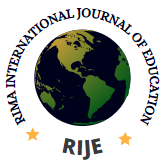Impact of Japanese Multiplication Technique on Academic Performance among Primary Five Pupils in Tureta, Sokoto State, Nigeria
Bello Shehu Aliyu
Department of Science Education, Faculty of Education, Sokoto State University
Abstract
The study investigated the impact of Japanese multiplication techniques on academic performance among primary five pupils in Tureta, Sokoto State, Nigeria. It employed quasi-experimental research design entailing pre-test and post-test. A simple random sampling technique through balloting method was used to select two schools out of fifty-six primary schools in Tureta. The two schools selected were assigned as experimental and control groups with a sample of 45 and 70 respectively. The groups were used as intact class. Two objectives and two research questions were raised with their equivalent null hypotheses. Multiplication Performance Test (MPT) was used to collect data. The reliability of the instrument was 0.86 through test retest approach analyzed by using Pearson Product Moment Correlation (PPMC). The data gathered were analyzed by using independent samplet-test at 0.05 level of statistical significance. The findings revealed a significant difference between experimental and control groups in favor of experimental group. But the Japanese Multiplication technique revealed no gender disparity. Among other recommendations include, the professional bodies like MAN, STAN, NMS etc and other educational stake holders should organize workshop and train primary school teachers of this innovative technique.
Keywords
Japanese, Multiplication, Academic Performance
Reference
Clement, D. H. (2002).Rethinking Concrete Manipulative. Teaching Children Mathematics 2 (5): 270-279.Retrieved from www.encyclopedia.com/doc/IGI-1723767.html on 1st July, 2016.
Douglas, O. & Olsen, N. (2008). The Effects of the Multiple Intelligence Teaching Strategy On Academic Achievement Of Eight Grade Math Students. Journal of Instructional Psychology, 35 (2): 182-187
Gugliotta, K.F. (2010). Gender Difference In Attitude Towards Mathematics And Science Among Elementary Students: An Exploration of The Role of Teachers. University of Tennessee Honors Thesis Projects. Retrieved from http://www.trace.tennessee.edu/utkchanhonoproj/1386 on 28th August, 2016
Inekwe, I. O. (2002). Sensitising Students Learning Of Mathematics Through Affective Means: A Focus On The Universal Basic Education. Nigeria Educational Forum. A Journal of Institute of Education, ABU Zaria, 16 (7): 76-81.
Muhammad, N. H. & Binji, B. U. (2016). Effect Of Gelosia Method Of Multiplication On Primary Five Pupils’ Mathematics Performance In Sokoto South Local Government (A Case Study of Dallatu Model Primary School). International Journal of Contemporary Education and Management (IJCEM). 11 (2): 35-44. ISBN 3609-7086
Ministry of Education (1958). Teaching Mathematics in Secondary Schools,
London press limited.
Odili, G. A. (2006). Mathematics In Nigeria Secondary School,: A Teacher’s Perspective published by REX Charles and Patrick limited in Association with Anachuna Educational Books – Port Harcourt
Wenyuan, G. U. (2001). The Lattice Method Use in Teaching Multiplication with Whole Numbers and Decimals to Students With Learning Disabilities. Department of special education, Winona State University Minnesota.
Yagar, R. (2001). The Constructivist Learning Model: Towards Real Reform in Science Education. Rt5 The Science teacher, 58 (6) 52-57.
